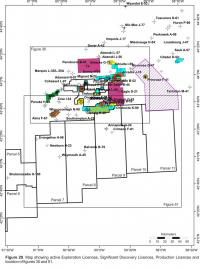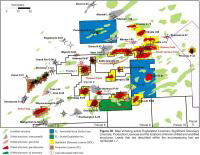Parcel Description and Exploration History
 Parcel 1 is located approximately 160 km offshore Nova Scotia, figure 1. The parcel surrounds Sable Island and water depths on the block are up to 50 metres. Parcel 1 is also adjacent to five significant discoveries (West Sable, West Olympia, Olympia, West Venture C-62 and West Venture N-91) and two producing gas fields (Thebaud and South Venture) (Figure 30). The above discoveries were made between 1971-1985. The Thebaud and South Venture gas fields are part of ExxonMobil’s Sable Offshore Energy Project and have been on production since 2000 and 2004, respectively. These fields are producing from early Cretaceous Missisauga and upper Jurassic Mic Mac fluvial deltaic sandstone reservoirs. To the end of March 2012, Thebaud and South Venture have produced 13.0 E9M3 (459 Bcf) and 7.3 E9M3 (256 Bcf) of gas, respectively.
Parcel 1 is located approximately 160 km offshore Nova Scotia, figure 1. The parcel surrounds Sable Island and water depths on the block are up to 50 metres. Parcel 1 is also adjacent to five significant discoveries (West Sable, West Olympia, Olympia, West Venture C-62 and West Venture N-91) and two producing gas fields (Thebaud and South Venture) (Figure 30). The above discoveries were made between 1971-1985. The Thebaud and South Venture gas fields are part of ExxonMobil’s Sable Offshore Energy Project and have been on production since 2000 and 2004, respectively. These fields are producing from early Cretaceous Missisauga and upper Jurassic Mic Mac fluvial deltaic sandstone reservoirs. To the end of March 2012, Thebaud and South Venture have produced 13.0 E9M3 (459 Bcf) and 7.3 E9M3 (256 Bcf) of gas, respectively.
 Since the 1960s, all or part of Parcel 1 has been licenced repeatedly by industry. During this time many seismic surveys were acquired and a considerable number of wells were drilled. The most recent Exploration Licences (EL) over the parcel were acquired by ExxonMobil Canada in the late 1990s and included: EL2356, EL2369, EL2370 and EL2371. During the time ExxonMobil held these licences they drilled one well on what is currently Parcel 1 (Adamant N-97). Adamant did not encounter commercial volumes of hydrocarbons, therefore the licence was allowed to expire.
Since the 1960s, all or part of Parcel 1 has been licenced repeatedly by industry. During this time many seismic surveys were acquired and a considerable number of wells were drilled. The most recent Exploration Licences (EL) over the parcel were acquired by ExxonMobil Canada in the late 1990s and included: EL2356, EL2369, EL2370 and EL2371. During the time ExxonMobil held these licences they drilled one well on what is currently Parcel 1 (Adamant N-97). Adamant did not encounter commercial volumes of hydrocarbons, therefore the licence was allowed to expire.
 The following three wells have been drilled on Parcel 1: Sable Island C-67, Migrant N-20 and Adamant N-97. Each well is described below.
The following three wells have been drilled on Parcel 1: Sable Island C-67, Migrant N-20 and Adamant N-97. Each well is described below.
Sable Island C-67 was spudded by Mobil Oil in June 1967. It was the first well drilled offshore Nova Scotia and was spudded, on land, in the middle of Sable Island. The well was drilled to determine the hydrocarbon potential of the sediments beneath Sable Island and to evaluate the flank of a deep seated structure. The well reached a total depth of 4604 m in the early Cretaceous lower Missisauga Formation. In the lower Mississauga, from approximately 4000 m to TD, questionable oil staining and minor mud-gas shows were encountered in a number of poor quality sands. Four DSTs were attempted three of which were mechanically successful. Of the mechanically successful DSTs, two recovered salt water and one (DST #4: 4447.6-4604.3 m) recovered minor gas and oil. There was no gas to surface during DST #4 but a small amount of gas and 50 cc of 39° API oil was recovered from the bottom hole sampler. The hydrocarbons recovered in DST #4 appear to be coming from a number of poor quality sands near the base of the well.
Migrant N-20 is located 12 km west of Sable Island and was spudded by Mobil et al in July 1977 in 14 m of water. The well was drilled to test for hydrocarbons in early Cretaceous Missisauga and late Jurassic Mic Mac sands trapped within a rollover anticline. The well reached a total depth of 4669 m in the Mic Mac Formation. Eight DSTs were attempted in three upper Mic Mac sands. Three of the DSTs were misruns, four had no recovery and one (DST #2: 4333.0-4361.7 m) flowed gas at a rate of 10 MMscf/d. Depletion was noted during DST #2 suggesting the zone may have limited areal extent or the presence of a boundary, such as a fault, near the wellbore. The two other Mic Mac sands that were tested appear gas bearing on logs but were unable to flow due to low effective porosities (<7%).
Adamant N-97 is located 8 km west of Sable Island and was spudded by Mobil et al in November 2000 in 17 m of water. The well was drilled to test for hydrocarbons in early Cretaceous Missisauga and late Jurassic Mic Mac Formation stacked fluvial deltaic sands trapped in a rollover anticline. The well reached a total depth of 4708 m in the upper Jurassic Mic Mac Formation. A number of gas bearing sands with fair to good reservoir quality were encountered in the lower Missisauga and upper Mic Mac formations. Two of these sands (Sands 2 & 3) are shown in figure 31. Sands 2 and 3 have log defined gas-water contacts and column heights of approximately 15 m, which is consistent with the amount of simple closure, as a result these zones are interpreted to leak at the north bounding fault. Thin gas pay was encountered in the upper Mic Mac Formation. This thin gas column is consistent with the minimal simple closure at this elevation and suggests the leak point is at the bounding fault. A total of 16 m of net gas pay was identified in Adamant N-97, however the field’s hydrocarbon reserves were deemed too small to be commercially viable.
The well results for Parcel 1 are summarized below.
Table 1 – Well Results Summary (Parcel 1)
|
Well |
Year |
TD (m) |
Target Formation |
Play / Trap |
|---|---|---|---|---|
|
Sable Island C-67 |
1967 |
4604 |
Logan Canyon & Missisauga (Cretaceous) |
Stratigraphic test & flank of deep seated structure |
|
Migrant N-20 |
1977 |
4669 |
Missisauga (early Cretaceous) & Mic Mac (late Jurassic) |
Rollover anticline |
|
Adamant N-97 |
2000 |
4708 |
Missisauga (early Cretaceous) & Mic Mac (late Jurassic) |
Rollover anticline |